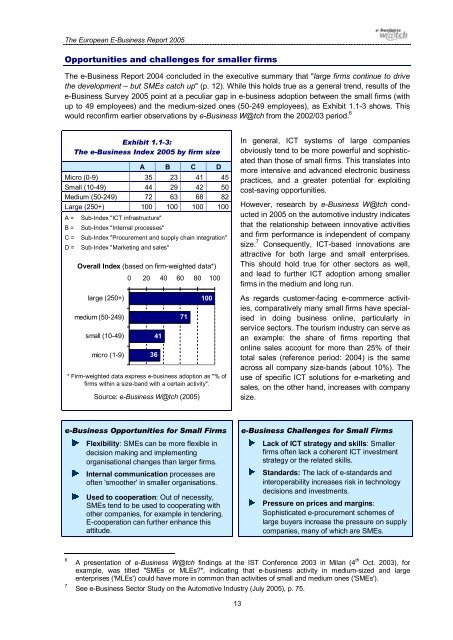The European e-Business Report The European e ... - empirica
The European e-Business Report The European e ... - empirica
The European e-Business Report The European e ... - empirica
Create successful ePaper yourself
Turn your PDF publications into a flip-book with our unique Google optimized e-Paper software.
<strong>The</strong> <strong>European</strong> E-<strong>Business</strong> <strong>Report</strong> 2005<br />
Opportunities and challenges for smaller firms<br />
<strong>The</strong> e-<strong>Business</strong> <strong>Report</strong> 2004 concluded in the executive summary that "large firms continue to drive<br />
the development – but SMEs catch up" (p. 12). While this holds true as a general trend, results of the<br />
e-<strong>Business</strong> Survey 2005 point at a peculiar gap in e-business adoption between the small firms (with<br />
up to 49 employees) and the medium-sized ones (50-249 employees), as Exhibit 1.1-3 shows. This<br />
would reconfirm earlier observations by e-<strong>Business</strong> W@tch from the 2002/03 period. 6<br />
Exhibit 1.1-3:<br />
<strong>The</strong> e-<strong>Business</strong> Index 2005 by firm size<br />
A B C D<br />
Micro (0-9) 35 23 41 45<br />
Small (10-49) 44 29 42 50<br />
Medium (50-249) 72 63 68 82<br />
Large (250+) 100 100 100 100<br />
A =<br />
B =<br />
C =<br />
D =<br />
Sub-Index "ICT infrastructure"<br />
Sub-Index "Internal processes"<br />
Sub-Index "Procurement and supply chain integration"<br />
Sub-Index "Marketing and sales"<br />
Overall Index (based on firm-weighted data*)<br />
large (250+)<br />
medium (50-249)<br />
small (10-49)<br />
micro (1-9)<br />
0 20 40 60 80 100<br />
36<br />
41<br />
71<br />
100<br />
* Firm-weighted data express e-business adoption as "% of<br />
firms within a size-band with a certain activity".<br />
Source: e-<strong>Business</strong> W@tch (2005)<br />
In general, ICT systems of large companies<br />
obviously tend to be more powerful and sophisticated<br />
than those of small firms. This translates into<br />
more intensive and advanced electronic business<br />
practices, and a greater potential for exploiting<br />
cost-saving opportunities.<br />
However, research by e-<strong>Business</strong> W@tch conducted<br />
in 2005 on the automotive industry indicates<br />
that the relationship between innovative activities<br />
and firm performance is independent of company<br />
size. 7 Consequently, ICT-based innovations are<br />
attractive for both large and small enterprises.<br />
This should hold true for other sectors as well,<br />
and lead to further ICT adoption among smaller<br />
firms in the medium and long run.<br />
As regards customer-facing e-commerce activities,<br />
comparatively many small firms have specialised<br />
in doing business online, particularly in<br />
service sectors. <strong>The</strong> tourism industry can serve as<br />
an example: the share of firms reporting that<br />
online sales account for more than 25% of their<br />
total sales (reference period: 2004) is the same<br />
across all company size-bands (about 10%). <strong>The</strong><br />
use of specific ICT solutions for e-marketing and<br />
sales, on the other hand, increases with company<br />
size.<br />
e-<strong>Business</strong> Opportunities for Small Firms<br />
Flexibility: SMEs can be more flexible in<br />
decision making and implementing<br />
organisational changes than larger firms.<br />
Internal communication processes are<br />
often 'smoother' in smaller organisations.<br />
Used to cooperation: Out of necessity,<br />
SMEs tend to be used to cooperating with<br />
other companies, for example in tendering.<br />
E-cooperation can further enhance this<br />
attitude.<br />
e-<strong>Business</strong> Challenges for Small Firms<br />
Lack of ICT strategy and skills: Smaller<br />
firms often lack a coherent ICT investment<br />
strategy or the related skills.<br />
Standards: <strong>The</strong> lack of e-standards and<br />
interoperability increases risk in technology<br />
decisions and investments.<br />
Pressure on prices and margins:<br />
Sophisticated e-procurement schemes of<br />
large buyers increase the pressure on supply<br />
companies, many of which are SMEs.<br />
6<br />
7<br />
A presentation of e-<strong>Business</strong> W@tch findings at the IST Conference 2003 in Milan (4 th Oct. 2003), for<br />
example, was titled "SMEs or MLEs?", indicating that e-business activity in medium-sized and large<br />
enterprises ('MLEs') could have more in common than activities of small and medium ones ('SMEs').<br />
See e-<strong>Business</strong> Sector Study on the Automotive Industry (July 2005), p. 75.<br />
13

















